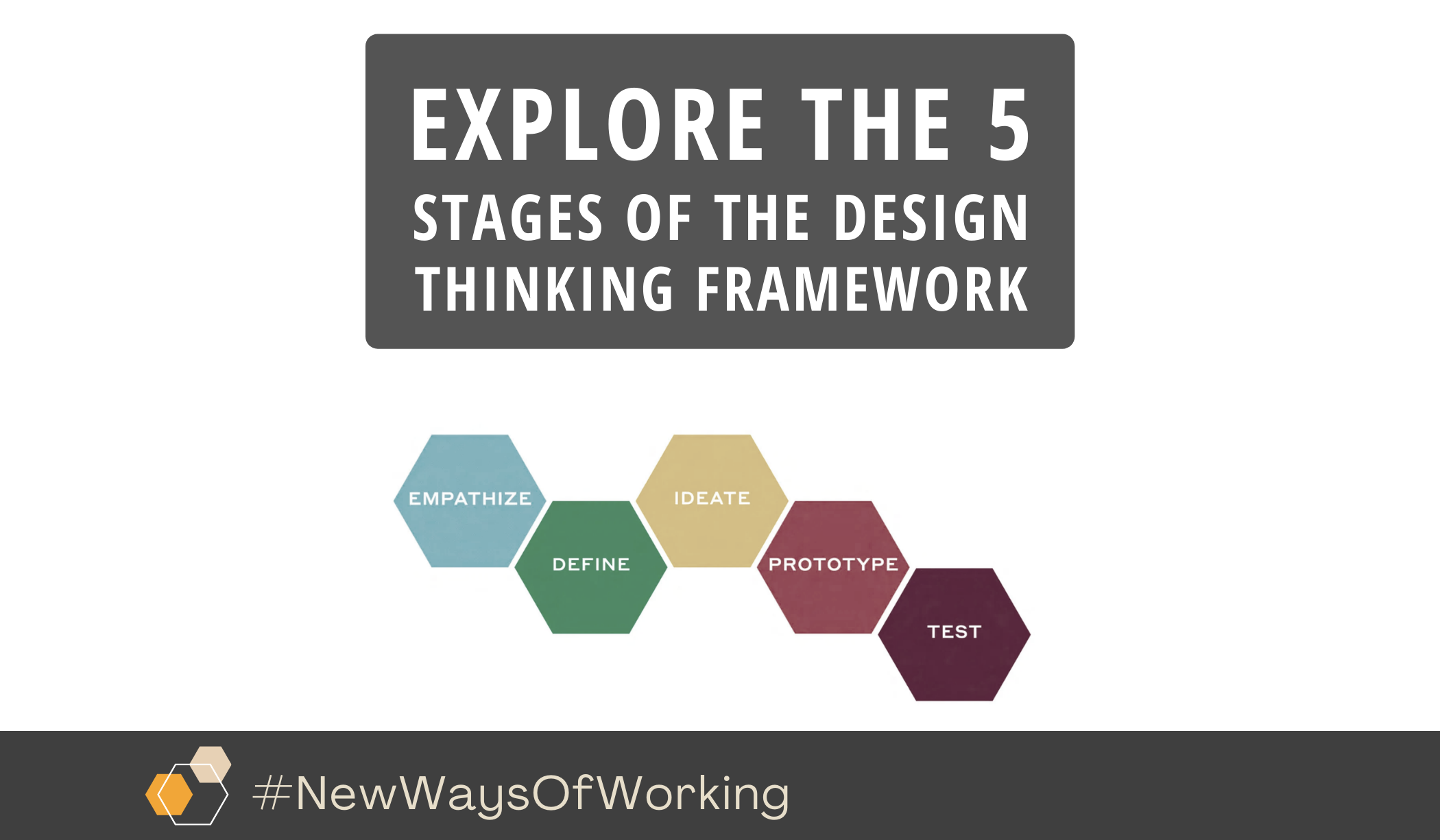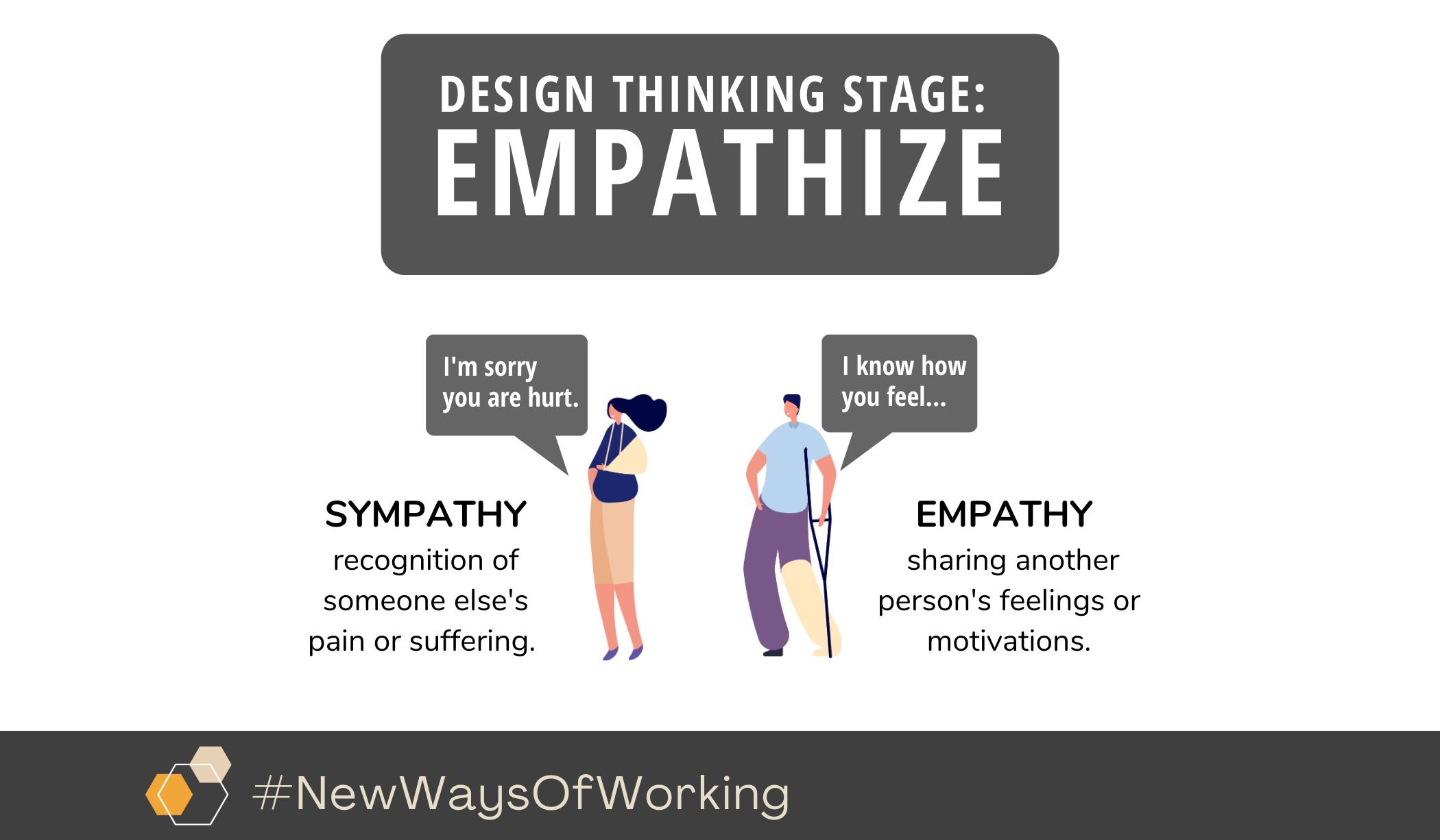What is the Design Thinking Process? A Leadership Primer on Human-Centered Design Methods
Are you looking for a resource to help your team become more innovative, create new ways of working, and build stronger leadership skills?
"Using empathy, Design Thinking aims to help teams collaboratively and iteratively solve problems based on the user's needs rather than the whims of the creators." - What is Design Thinking, and Why is it so Popular?
Discover our go-to resource for mastering the art of Design Thinking so you can easily implement effective new ways of working. We provide tools and tips for entrepreneurs, teams, and leaders that will enable them to harness the power of Design Thinking to drive meaningful change.
Explore the 5-Stages of the Design Thinking Framework
Try not to think of Design Thinking as a 1.2.3. stop, rinse, and repeat type process. Instead, the iterative disposition of design thinking is a collection of working methods and tools a leader can cycle through regularly during a project or design challenge.
We use the Design Thinking framework to tackle complex user problems with many variables and moving parts. The design thinking approach lets leaders learn about their users, identify many solutions to the problem, and start testing those solutions, revealing more insight that can be applied to future iterations.
The 5-stages of the Design Thinking Framework are:
Empathize: Identify and understand user needs and pain points.
Define: Identify and define the problem to solve.
Ideate: Generate as many ideas and potential solutions as possible.
Prototype: Narrow ideas to a sub-set of concepts and build mock-ups to test with users.
Test: Test if your ideas solve the problem by testing with users.
Design Thinking Stage: Empathize
Empathy is the first and most crucial step in the Design Thinking framework.
What is Empathy?
Empathy allows us to walk in the shoes of another person, or our user, and see first-hand, what they experience. To effectively predict a user's behaviours and preferences, a team must first understand their needs, objectives, motivations, products they prefer, and services involved in their experiences.
"Design Thinking aims to help teams build skills in empathy, collaboration, leadership, and problem solving." - What is Design Thinking, and Why is it so Popular?
How to Practice Empathy:
Take a beginner's mindset: Approach the problem with fresh eyes like a beginner.
Re-create pain points: Simulate the scenario to experience the users' challenges and better understand the issue.
Connect with users: Complete an empathy map to dive deeper into their experiences and pain points.
Design Thinking Stage: Define
Leverage what you learn in the Emphasize Stage to translate insight into a defined problem statement or project's vision.
What is the Define stage?
Often the trickiest of the five stages, the Define stage in Design Thinking, is all about diagnosing the right problem using the information a team gathers from their users and stakeholders. Prioritizing needs and deciding where to allocate resources can be complex. To define a problem, create a synthesized view of the insights gathered in the Empathize Stage. Leaders can then use these inputs to guide their teams when describing the problem.
"Experiment with tools and resources to get closer to the problem funnel to communicate issues effectively."- What is Design Thinking, and Why is it so Popular?
Writing a Problem Statement:
A good problem statement avoids naming specific solutions, keeps the scope open enough to inspire creativity but specific enough to enable the team to move forward, and avoids jargon.
Get started with a problem funnel: Do you need help explaining a business problem? Try a problem funnel:
State the problem in 40 words.
Next, state it in 20 words.
Refine to 10 words.
Finally, to just 5 words.
Download a free Problem Framing Template.
Design Thinking Stage: Ideate
Ideation is the third stage of Design Thinking and the least structured.
What is ideation?
Ideation is an exciting part of the process when the imagination can run wild. The objective is to produce many ideas that the team can then narrow down to the best and most useful ones. Ideation ignites innovation and aims to get apparent solutions out of the team's head early and steer beyond them. Base your business strategies on ideas. Although internal ideas are essential, customer ideas are becoming more crucial. The users are the ones who buy the products and use the services, so making sure to deliver what they want is a top priority.
"The pain points identified during the empathize phase will guide the ideation stage of the design thinking project." - What is Design Thinking, and Why is it so Popular?
Hosting an Ideation Session: Diverge Then Converge
The pain points identified during the empathize phase will guide the ideation stage of the design thinking project. The team's goal is to propose solutions to these challenges. In design thinking, ideation is about developing ideas that can be prototyped and tested. Then, select the ideas that will be prototyped and keep a record of those in an idea parking lot.
Diverge: generate as many ideas as possible.
Converge: Prioritize ideas based on impact/feasibility
Design Thinking Stage: Prototype
Design Thinking and User Experience design benefit from prototyping, enabling us to quickly test and improve our ideas.
What is a Prototype?
A prototype is a mock-up of a concept built with the purpose of testing with small user groups. This process can validate the hypotheses and potential solutions discovered during previous design stages. Design teams create prototypes to test their idea before investing resources in them. So prototyping is the step between formalizing a concept and testing it with larger user groups. As a result, prototyping allows designers to test a design's feasibility and investigate how trial users perceive it. Doing so allows design concepts to be thoroughly tested and explored before too many resources are committed.
"The pain points identified during the empathize phase will guide the ideation stage of the design thinking project." - What is Design Thinking, and Why is it so Popular?
How to Practice Prototyping:
Low-Fidelity prototypes: Start with simple, low-tech concepts you can test quickly.
High-Fidelity prototypes: Advance tech and tools to take your prototypes to the next level.
Follow @designACE.ca on Instagram to discover solutions for remote & hybrid team engagement. #NewWaysOfWorking
Design Thinking Stage: Test
Testing may stimulate new ideas for solving the user problem.
What is testing?
At this point in the process, we need to test the solutions to continue building on them and refining them into scalable solutions. It is crucial to try out our concepts with real people before going to market. To define a minimum viable product, the team can test end-to-end with users to crawl before walking and running to launch.
"Practice the principle of failing quickly and cheaply with low-fidelity prototypes. The trick is quick to build and costs minimal (if anything) but can elicit helpful feedback." - What is Design Thinking, and Why is it so Popular?
Defining a Minimum Viable Product (MVP)
An MVP is a version of a new product with "just enough" functionality to engage and satisfy early users. In addition, an MVP enables them to provide feedback we can use to iterate the final product. This method has proven the fastest and least costly approach to designing and validating a product before investing time, money, and effort to build and launch it. In addition, using feedback from the prototyping phase can pinpoint the features that drive the most value and meet the most critical user needs to make the MVP.
Download a free Rose, Bud, Thorn template for testing your MVP.
Buy our New Book: What is Design Thinking and, Why is it so Popular?
Design Thinking has been one of the most popular approaches to problem-solving in recent years. Our new Book, What is Design Thinking and, Why is it so Popular?, explores the power of Design Thinking and how to implement it effectively in business.
Heighten your leadership skills with design challenges and engaging team-building activities like empathy mapping to translate user insight into actionable solutions.
Learn the principles of Design Thinking and how to use them to develop innovative solutions.
Create a safe work environment using empathy-based tools and resources.
Gain insights into developing a successful empathy-based design thinking project.
Discover how to stay motivated and organized during the process.
If you are looking to take your Design Thinking skills to the next level, buy this Book now and start unlocking the potential of this powerful and effective problem-solving tool.
What is Design Thinking and, Why is it so Popular?
Available exclusively through Amazon in paperback, hardcover, and eBook for a limited time, it is free for all KindleUnlimted subscribers.
We hope you enjoyed this Leadership Primer on Human-Centered Design Methods and take the time to learn more about the Design Thinking Process.








